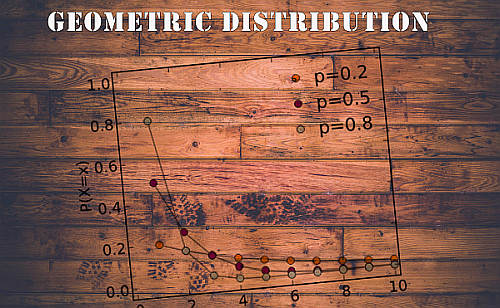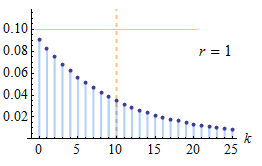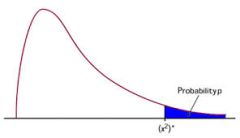Geometric Probability Calculator
Instructions: Use this Geometric Probability Calculator to compute Geometric distribution probabilities using the form below. Please type the population proportion of success p (a number between 0 and 1), and provide details about the event you want to compute the probability for (notice that the numbers that define the events need to be integer):
Geometric Probability Calculator
More about the geometric distribution probability so you can better use this calculator.
The geometric probability is a type of discrete probability distribution \(X\) that can take random values on the range of \([1, +\infty)\). The random variable \(X\) is the number of trials required to get the first successes.
How do you compute the geometric probability
For a value \(x \in [1, +\infty)\), the geometric probability is computed using the following geometric probability formula:
\[ \Pr(X = i) = (1-p)^{i-1} \times p \]Using the above geometric distribution calculator , we can compute probabilities of the form \(Pr(a \le X \le b)\), of the form \(\Pr(X \le b)\) or of the form \(\Pr(X \ge a)\).
Type the appropriate parameters for \(p\) in the text box above, select the type of tails, specify your event and compute your desired geometric probability.

Geometric distribution calculator with steps
In order to use this calculator you need to know two things: One is the probability of success p of each trial. Also, you need to know the event for which you want to compute the probability.
For example, you may have independent trials, and the probability of success may be p = 0.3, so there is your probability. Then, you may be interested in knowing about the probability that the first success will happen between 4 and 6 trials. So then, in this case [4, 6] is your event.
The Geometric distribution and the Binomial Distribution
You may be wondering, this geometric distribution seems a whole lot like the Binomial distribution. And to an extent, the setting are very similar, as for both distributions you will have independent trials, with a fixed probability of success.
And for both the geometric distribution and the binomial distribution, you are interested in trial successes. But the difference is that in the geometric distribution you want to know how many trial it takes to get the first success, whereas in the binomial distribution you count how many successes happen in N trials.

What is the expected value of the Geometric distribution
The steps to calculate the expected value of the Geometric distribution are very simple: 1) You identify the probability of success p, and 2) you calculate the expected value by computing the inverse, which is \(E(X) = \frac{1}{p}\).
For example, if you have a geometric distribution with a probability of success of p = 0.1, then the corresponding expectecd value is \(E(X) = \frac{1}{p} = \frac{1}{0.1} = 10.\).
Other discrete probability calculators
If instead you need to compute binomial probabilities, you can use our binomial calculator instead. Another notable discrete distribution you may be interested in is the Negative Binomial distribution .
Also, you can use our Poisson distribution probability calculator to deal with any application involving the Poisson probabilities, which are fairly common in lots of applications
Another tightly related distribution is the hypergeometric distribution, which is similar to the binomial distribution, only that in the case of the hypergeometric, the probability of success is not fixed.



